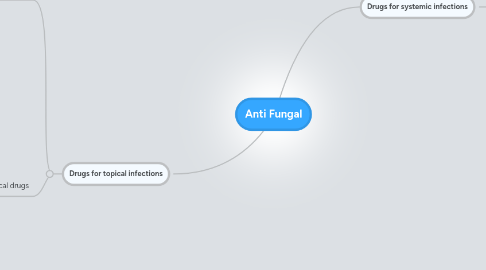
1. Drugs for systemic infections
1.1. polyene macrolides
1.1.1. Amphotericin B
1.1.1.1. 4 formulas
1.1.1.1.1. C-AMB
1.1.1.1.2. L-AMB
1.1.1.1.3. ABLC
1.1.1.1.4. ABCD
1.1.1.2. mechanism
1.1.1.2.1. binds to ergosterol in the cell membrane
1.1.1.2.2. only binds to fungal sterol, not human cholesterol
1.1.1.3. pharmacokinetics
1.1.1.3.1. NOT absorbed orally, only IV
1.1.1.3.2. PPB more than 90%
1.1.1.3.3. long half life (15 days)
1.1.1.3.4. does is 5mg/kg
1.1.1.3.5. does for C-AMB is 0.6mg/kg
1.1.1.4. advantages
1.1.1.4.1. life saving drug
1.1.1.4.2. high anti fungal activity
1.1.1.4.3. broad anti fungal spectrum
1.1.1.4.4. fungicidal activityh
1.1.1.4.5. negligible fungal resistance
1.1.1.5. disadvantages
1.1.1.5.1. nephrotoxicity
1.1.1.5.2. fever and chills
1.1.1.5.3. other side effects
1.1.1.5.4. azotemia (elevation of BUN) in 80% of patients
1.1.1.5.5. anemia
1.1.1.6. therapeutic uses
1.1.1.6.1. all life threatening fungal infections
1.1.1.6.2. patients with severe neutropenia and fever that did not respond to antibacterial agents for 5-7 days
1.2. pyrimidine antimetabolites
1.2.1. flucytosine
1.2.1.1. mechanism
1.2.1.1.1. impairs DNA synthesis
1.2.1.2. spectrum
1.2.1.2.1. cryptococcus neoformans
1.2.1.2.2. some candida
1.2.1.3. pharmacokinetics
1.2.1.3.1. complete & rapid absorption orally
1.2.1.3.2. minimal PPB
1.2.1.3.3. volume of distribution about total body water
1.2.1.3.4. 1-2 hours to active peak plasma concentration
1.2.1.3.5. dose is 50-150mg/kg/day (dividid by 4 doses)
1.2.1.3.6. 80% excreted in urine unchanged
1.2.1.3.7. half life 3-6 hours
1.2.1.3.8. dose reduced with renal failure
1.2.1.4. therapeutic uses
1.2.1.4.1. in combination with AMB
1.2.1.4.2. in combination with fluconazole
1.2.1.5. adverse effects
1.2.1.5.1. common
1.2.1.5.2. bone marrow depression
1.3. azoles
1.3.1. Imidazoles & triazoles
1.3.1.1. mechanism
1.3.1.1.1. inhibit fungal growth
1.3.1.2. spectrum
1.3.1.2.1. broad anti fungal spectrum
1.3.1.3. types
1.3.1.3.1. fluconazole
1.3.1.3.2. itraconazole
1.3.1.3.3. posaconazole
1.3.1.3.4. voriconazole
1.3.1.4. general, common adverse effects
1.3.1.4.1. nausea
1.3.1.4.2. vomiting
1.3.1.4.3. diarrhea
1.3.1.4.4. headach
1.3.1.4.5. abdominal pain
1.4. echinocandins
1.4.1. general features
1.4.1.1. active against candidiasis and aspergillus (including the resistant to azoles)
1.4.1.2. act by inhibiting synthesis of beta glucan (important for the cell wall) which causes cell lysis
1.4.1.3. given IV only (not absorbed orally)
1.4.2. types
1.4.2.1. caspofungin
1.4.2.1.1. metabolism
1.4.2.1.2. therapeutic use
1.4.2.1.3. dose
1.4.2.2. micafungin
1.4.2.2.1. metabolism
1.4.2.2.2. therapeutic use
1.4.2.2.3. dose
1.4.2.3. anidulafungin
1.4.2.3.1. treatment of esophageal candidiasis
1.4.2.3.2. 100mg followed by 50mg daily
1.5. allylamines
1.5.1. terabinafine
1.5.1.1. inhibits synthesis of ergosterol
1.5.1.2. pharmacokinetics
1.5.1.2.1. well absorbed orally but goes first pass metabolism (bioavailability 40%)
1.5.1.2.2. PPB 99%
1.5.1.2.3. accumulated in skin, nails, and fat
1.5.1.2.4. initial half life is 12 hours but extends to 200-400 hours in steady state
1.5.1.3. therapeutic uses
1.5.1.3.1. onychomycosis
1.5.1.3.2. candidiasis
1.5.1.3.3. dermatophytosis
1.5.1.3.4. pityriasis
1.5.1.3.5. tinea capitis
1.5.1.4. adult oral dose is 250mg daily
2. Drugs for topical infections
2.1. systemic drugs
2.1.1. griseofulvin
2.1.1.1. inhibits mitosis by binding to tubulin
2.1.1.2. effective in topical dermatophytosis
2.1.1.2.1. trichophytin
2.1.1.2.2. microsporum
2.1.1.2.3. epidermophyton
2.1.1.3. dosing (oral)
2.1.1.3.1. children
2.1.1.3.2. adults
2.1.1.4. adverse effects
2.1.1.4.1. nausea
2.1.1.4.2. vomiting
2.1.1.4.3. diarrhea
2.1.1.4.4. dry mouth
2.1.1.4.5. headache
2.1.1.4.6. peripheral neuritis
2.1.1.4.7. vertigo
2.1.1.4.8. lethargy
2.1.1.4.9. blurred vision
2.1.1.4.10. hepatotoxicity
2.1.1.4.11. neutopenia
2.1.1.4.12. leucopenia
2.1.2. lodide
2.2. topical drugs
2.2.1. nystatin
2.2.1.1. same action of AMB
2.2.1.2. obtained from streptomyces noursei
2.2.1.3. only topically due to to hight systemic toxicity
2.2.1.4. used for vaginal candidiasis
2.2.2. haloprogin
2.2.2.1. halogenated phenolic ether
2.2.2.2. spectrum
2.2.2.2.1. epidermophyton
2.2.2.2.2. trichophyton
2.2.2.2.3. microsporum
2.2.2.2.4. pityrosporum
2.2.2.2.5. candida
2.2.2.3. therapeutic use
2.2.2.3.1. tinea pedis
2.2.2.3.2. tinea cruris
2.2.2.3.3. tinea corporis
2.2.2.3.4. tinea manuum
2.2.2.3.5. tinea versicolor
2.2.2.4. twice a day on infected skiing for 2-4 weeks
2.2.3. tolnaftate
2.2.3.1. treatment of most cutaneous mycoses
2.2.3.1.1. trichophton rubrum
2.2.3.1.2. t. mentagrophytes
2.2.3.1.3. t. tonsurans
2.2.3.1.4. e. floccosum
2.2.3.1.5. microsporum gypseum
2.2.3.1.6. m. canis
2.2.3.1.7. m. audouinii
2.2.3.1.8. m. furfur
2.2.3.2. 1% preparation
2.2.4. naftifine
2.2.4.1. inhibits biosynthesis of ergosterol
2.2.4.2. broad spectrum
2.2.4.3. 1% cream or gel
2.2.4.4. used for
2.2.4.4.1. tinea curis
2.2.4.4.2. tinea corporis
2.2.4.4.3. cutaneous candidiasis
2.2.4.4.4. tinea versicolor
2.2.5. imidazoles
2.2.5.1. miconazole
2.2.5.1.1. 2% and 4% vaginal cream
2.2.5.1.2. used for
2.2.5.1.3. or vaginal suppositories at bed time
2.2.5.1.4. adverse effects
2.2.5.2. econazole
2.2.5.2.1. deschloro derivative or miconazole
2.2.5.2.2. penetrates the stratum corneum - found in the mid dermis
2.2.5.2.3. less than 1% in blood
2.2.5.2.4. 1% cream
2.2.5.2.5. used for
2.2.5.3. clotrimazole
2.2.5.3.1. systemic absorption
2.2.5.3.2. used for
2.2.5.3.3. remains in vagina for 3 days after application
2.2.5.3.4. available as
2.2.5.3.5. adverse effects
2.2.5.4. butoconazole
2.2.5.4.1. similar to clotrimazole
2.2.5.4.2. 2% vaginal cream
2.2.5.4.3. slower response during pregnancy, so a 6 days course is recommended in 2nd and 3rd trimester
2.2.5.5. tioconazole
2.2.5.5.1. for vulvovaginal candidiasis
2.2.5.5.2. single dose of 300mg at bed time
